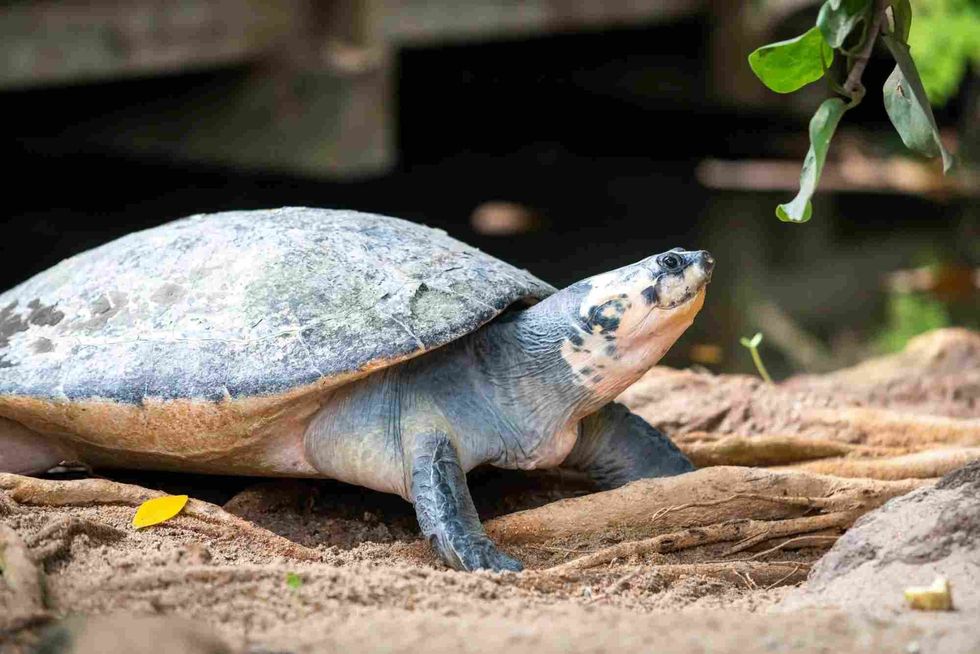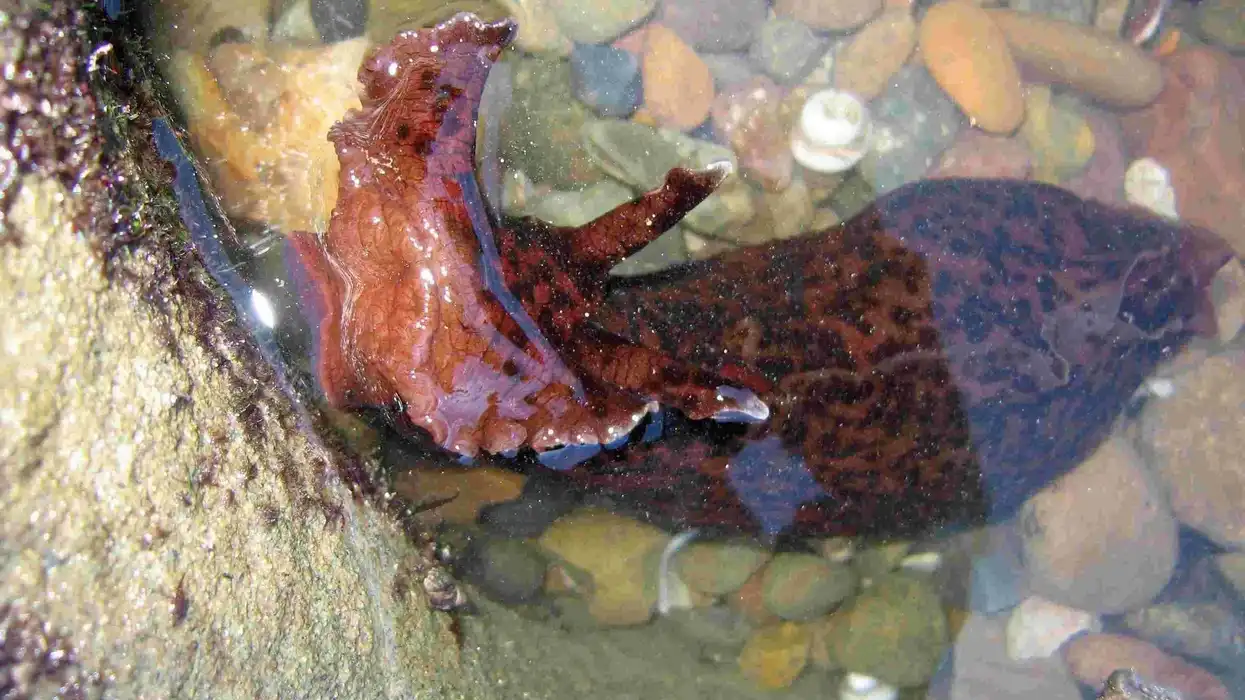Flatback turtles derive their name from their flat carapace, or shells, which differ from the curved shells of other sea turtle species. The flatback turtle (scientific name Natator depressus) has a flat shell with a lower dome, flatter than most other sea turtles and is given this popular name.
It exists in a range of colors from olive green to gray, and has a cream underside.
The diet of flatbacks consists of sea cucumbers, corals, jellyfish, and other marine species. Out of all the seven sea turtle species, the flatback has the shortest geographic distribution. Their range is restricted to the sandy beaches and shallow waters of the Australian continental shelf, southern Indonesia, and southern Papua New Guinea.
If you enjoyed these Australian flatback turtle facts, you will find the article on other turtle species like the Mary River turtle or mata mata turtle very interesting.
Flatback Sea Turtle Interesting Facts
What type of animal is a flatback sea turtle?
Flatback sea turtle classification lists it as a reptile, and it is a species of sea turtle found only on sandy beaches and in shallow coastal waters of Australia and Papua New Guinea.
What class of animal does a flatback sea turtle belong to?
The flatback turtle is a sea turtle species belonging to the class of reptiles.
How many flatback sea turtles are there in the world?
According to the limited sources that are available, there are between 20,000-21,000 nesting females.
Where does a flatback sea turtle live?
Coastal seas and open oceans comprise the geographic range of flatbacks. The primary distribution of flatbacks, or habit of choice, is in shallow coastal waters with a maximum depth of 200 ft (60.9 m).
Flatbacks live on Australia's continental shelf in turbid inshore seas, bays, coastal coral reefs, and grassy shallow waters. Sand beaches in tropical and subtropical climates are the preferred nesting sites by females.
What is a flatback sea turtle's habitat?
The tropical parts of the continental shelf and coastal seas of northern Australia, southern Indonesia, and southern Papua New Guinea comprise the geographic range of this species. The flatback sea turtle can also be found in the coastal waters of northern Australia, the Tropic of Capricorn, and the coastal regions of Papua New Guinea.
Eastern Queensland, the Torres Strait and the Gulf of Carpentaria, the Northern Territory, and Western Australia are the locations where nesting beaches are found.
Who do flatback sea turtles live with?
Adult flatbacks live in solitude apart from during the breeding season.
How long does a flatback sea turtle live?
The most reliable prediction is that the average flatback sea turtle lifespan is somewhere around 80 years.
How do they reproduce?
Flatback sea turtle reproduction process is similar to the other marine turtle species. A flatback sea turtle reaches sexual maturity between the ages of 7-50. An adult female will lay her eggs every two to three years between November and December.
The adult female lays 50 eggs at a time. Mating takes place when males and females are at sea. This means males will never return to nesting beaches after the eggs hatch.
The nesting season can extend anywhere from November to January, depending on the nesting sites. Flatback hatchlings benefit from their huge size because it protects them from predators. Because of their size, the sex can typically be identified simply by looking at them.
What is their status of conservation?
The flatback sea turtle conservation status is categorized as Data Deficient on the IUCN Red List. In Australia, the flatback sea turtle is classified as Vulnerable.
This is because of several conservation threats recognized in the area. These conservation threats include predators like seawater crocodiles and hunters who capture these turtles by mistake. Capture, egg harvesting, loss of nesting sites, open ocean pollution, oil spills, and a variety of sea hunters are all conservation threats to sea turtles.
Flatback Sea Turtle Fun Facts
What do flatback sea turtles look like?
The flatback turtle gets its name from its flat shell or carapace. The shell has a pale greenish gray to olive green tint, which matches the color of its head. The outside borders of the shell have a noticeable upturn. The underside, often known as the plastron, has a considerably lighter pale yellow tint.
How cute are they?
There is a significant population of sea animal enthusiasts who find this species very cute. Aquarium enthusiasts will love this turtle because of its unique and beautiful appearance.
How do they communicate?
Not much is known about how Natator depressus turtles communicate with each other. Touch and sight are considered to be the main methods of communication for these reptiles communicate.
How big is a flatback sea turtle?
Adult flatback sea turtles are fairly large, with their length ranging from 31-37 in (80-95 cm). This makes its length somewhere between 13-15 times smaller than saltwater crocodiles.
How fast can a flatback sea turtle move?
Flatback sea turtles have smooth shells and paddle-like flippers that allow them to move through the ocean water at speeds of up to 14.9 mph (24 kph).
How much does a flatback sea turtle weigh?
The average flatback sea turtle weight is somewhere around 220 lb (100 kg) for an adult.
What are the male and female names of the species?
There is no specific name assigned to the males and females of this reptile species.
What would you call a baby flat-back sea turtle?
A baby flatback sea turtle can be referred to as a hatchling.
What do they eat?
The flatback sea turtle diet is primarily carnivorous and consists of several ocean species. Jellyfish, sea cucumbers, soft corals, mollusks, prawns, bryozoans, and various invertebrates and seaweed are among the soft-bodied prey eaten by flatback turtles.
Are they dangerous?
Flatback turtles are reptiles that may carry salmonella bacterium which can be deadly. The CDC emphasizes that keeping any turtle less than 4 in (10 cm) as a pet is banned.
Would they make a good pet?
Casual collectors should avoid aquatic turtles as pets. They are difficult to care for and frequently carry Salmonella germs. Keeping such reptiles in your aquarium requires good hygiene and caution.
Did you know...
Flatback sea turtles consume jellyfish to keep their populations under control.
Flatback sea turtles cannot retract their flippers and head inside their shells. They are not able to protect themselves from predators for most of their lives in the ocean. Their anatomy allows them to be more nimble underwater, but it also leaves them extremely susceptible when it is exposed to predators.
What is the difference between the flatback sea turtle and the green sea turtle?
The green turtle is the largest of the sea turtles. Unlike flatback sea turtles, this species is a herbivore. Their name is given to this species due to their green color cartilage and they do not a flat shell like the flatback sea turtle. However, their reproductive cycle, communication, and other characteristics resemble that of flatback sea turtles.
How deep is a flatback turtle egg hole?
The flatback turtle egg hole depth can be somewhere between 5-7 in (12.7-17.7 cm). These burrows are easy for the mother to reach into to protect the eggs and provide a suitable environment.
Here at Kidadl, we have carefully created lots of interesting family-friendly animal facts for everyone to discover! Learn more about some other reptiles from our hawksbill sea turtle facts and Chinese softshell turtle facts pages.
You can even occupy yourself at home by coloring in one of our free printable flatback sea turtle coloring pages.










